| Article ID | Journal | Published Year | Pages | File Type |
|---|---|---|---|---|
| 8073789 | Energy | 2016 | 7 Pages |
Abstract
HCS (Hollow carbon spheres) covered with metal oxide nanoparticles (SnO2 and MnO2, respectively) were successfully synthesized and investigated regarding their potential as anode materials for lithium-ion batteries. Raman spectroscopy shows a high degree of graphitization for the HCS host structure. The mesoporous nature of the nanocomposites is confirmed by Brunauer-Emmett-Teller analysis. For both metal oxides under study, the metal oxide functionalization of HCS yields a significant increase of electrochemical performance. The charge capacity of HCS/SnO2 is 370Â mAÂ hgâ1 after 45 cycles (266Â mAÂ hgâ1 in HCS/MnO2) which clearly exceeds the value of 188Â mAÂ hgâ1 in pristine HCS. Remarkably, the data imply excellent long term cycling stability after 100 cycles in both cases. The results hence show that mesoporous HCS/metal oxide nanocomposites enable exploiting the potential of metal oxide anode materials in Lithium-ion batteries by providing a HCS host structure which is both conductive and stable enough to accommodate big volume change effects.
Keywords
Related Topics
Physical Sciences and Engineering
Energy
Energy (General)
Authors
K. Wenelska, A. Ottmann, P. Schneider, E. Thauer, R. Klingeler, E. Mijowska,
